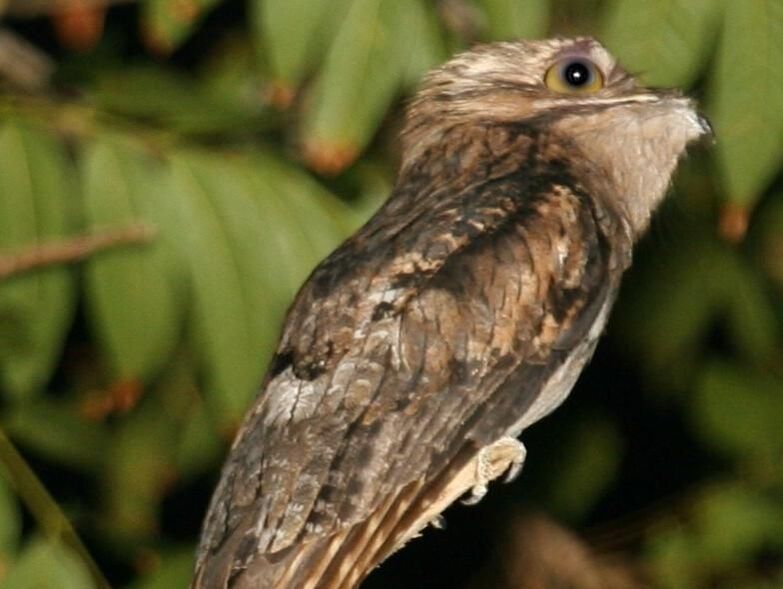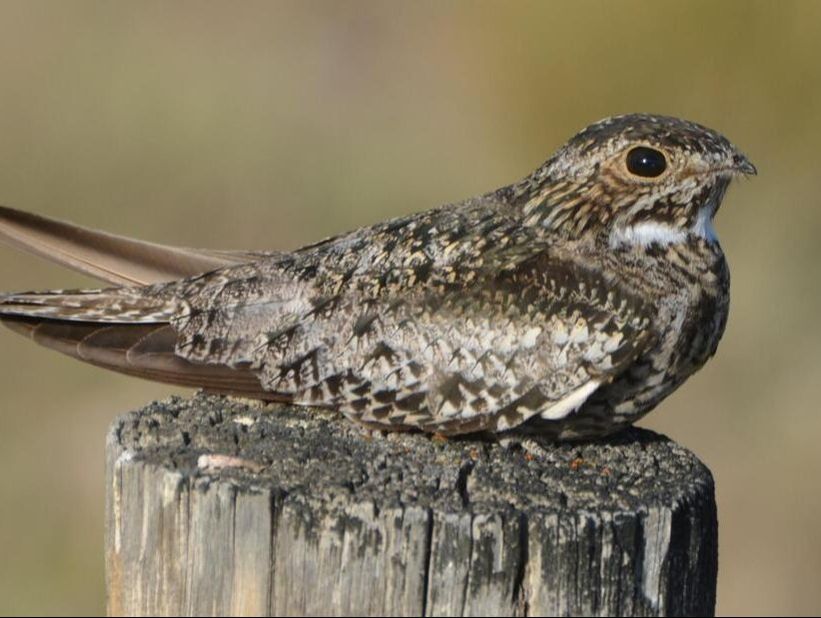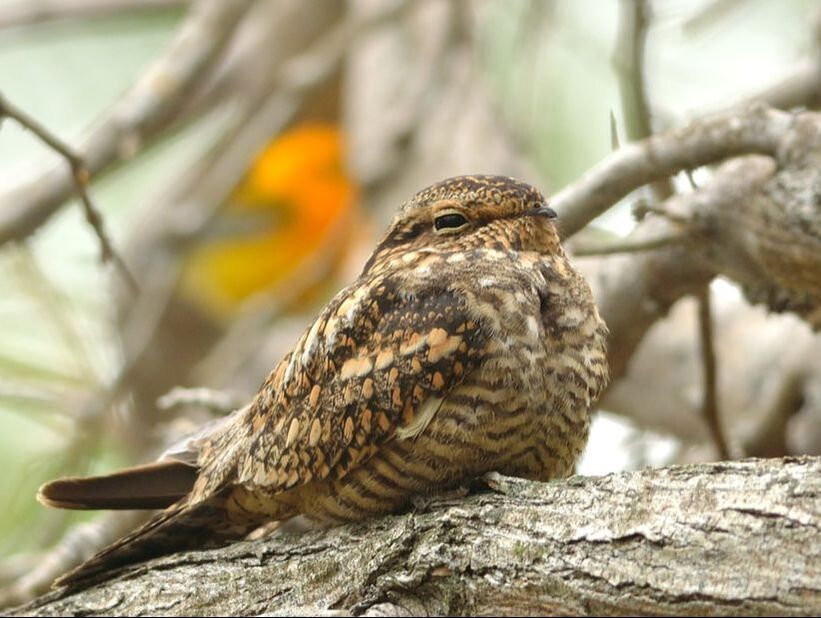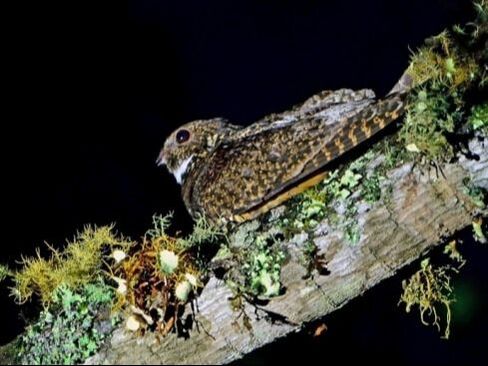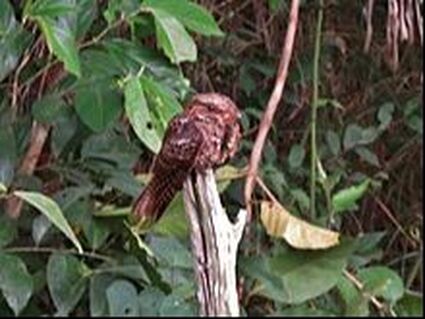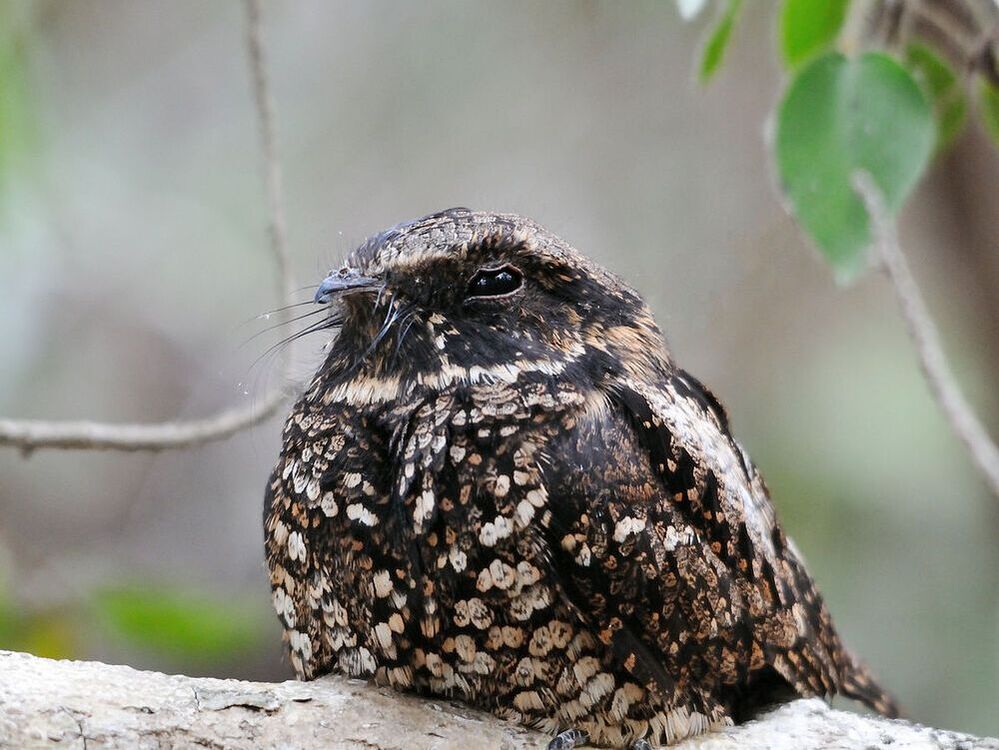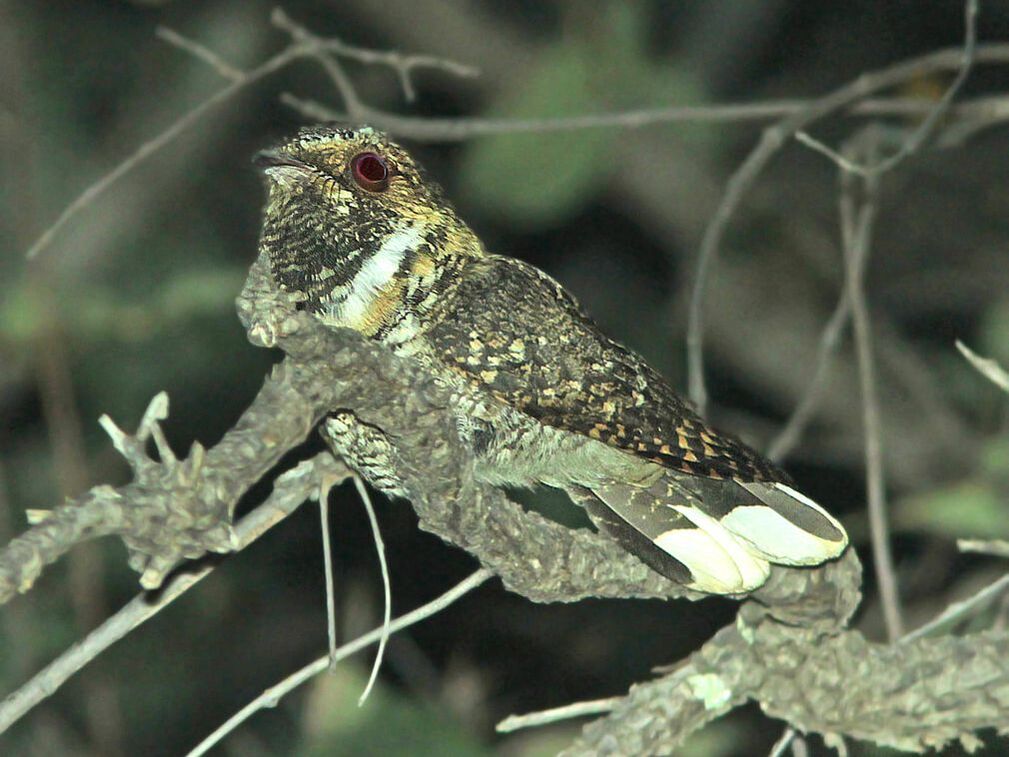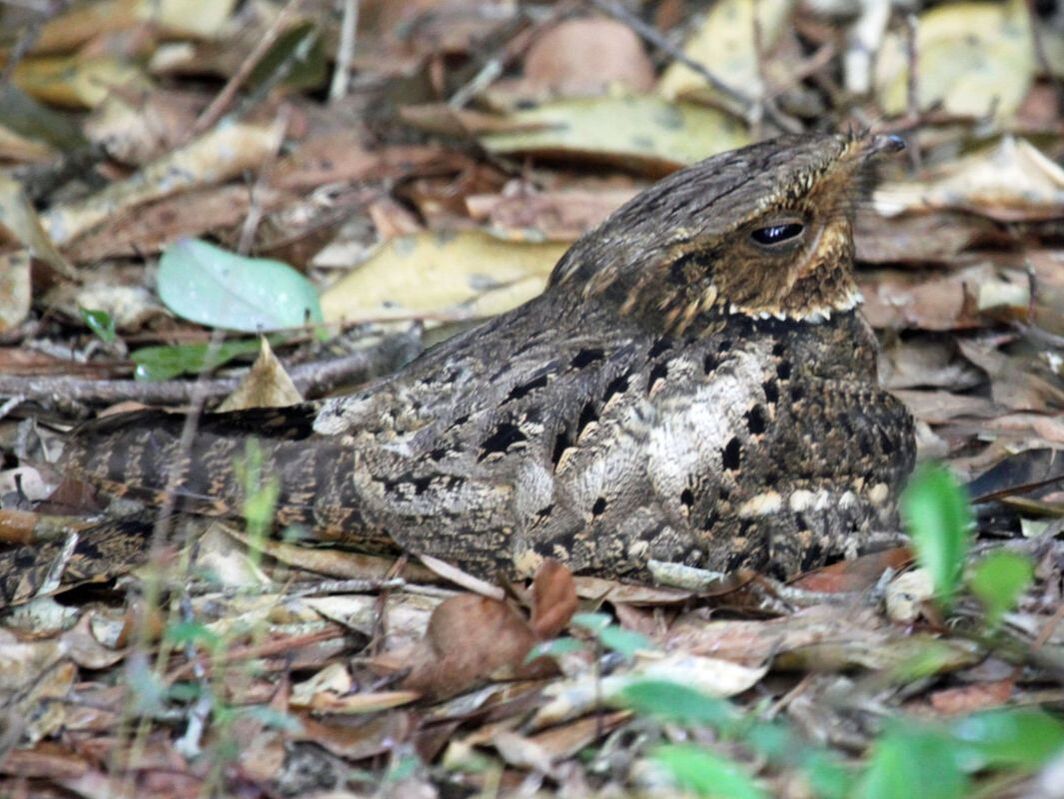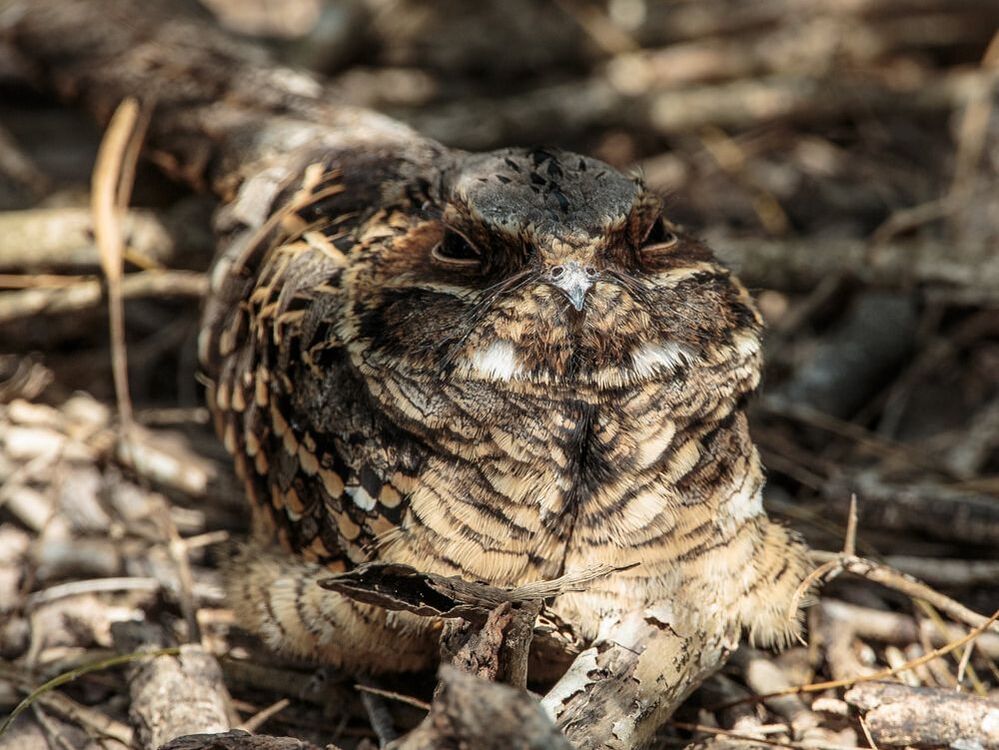Caprimulgios & Potoo - in Belize
Northern Potoo
Northern Potoo - Bizarre, big-headed, and bug-eyed nocturnal bird with yellow eyes and cryptically streaked plumage. Found in wooded and semiopen habitats in tropical lowlands, including mangroves. Roosts upright on branches, where it blends in and looks like a broken tree branch. At night in a flashlight beam, eyes reflect like brilliant amber coals (nightjar eyes are duller and owl eyes have a dull reflection and are rarely visible). Hunts from posts and prominent perches; sallies out for insects and often returns to the same perch.
BELIZE HABITAT - Mid-strata; forest clearings and edge, second growth and other disturbed habitats, rural communities. Where can you find this bird in Belize? Uncommon to locally fairly common resident on mainland; recorded twice from Ambergris Caye, where possibly resident. Interesting Facts
|
Common Nighthawk
Common Nighthawk - Camouflaged to blend into roosts. Intricately patterned with gray and brown. Often roosts along tree branches or on the ground. Feeds at night on large insects. Watch for them flying under bright lights at ballgames or supermarkets. Distinctive fluttering flight style, with wings usually held in a V-shape between bursts of flaps and maneuvers to snatch insects. Very similar to Lesser and Antillean Nighthawks; note voice and location of white wing patch close to base of primaries.
BELIZE HABITAT - During day, perches lengthwise on tree branches. Feeds on the wing at night; best seen at dawn and dusk. Nests on ground and flat gravel roofs of buildings. Where can you find this bird in Belize? Summer resident, early April to late October in Mountain Pine Ridge and locally in coastal lowlands (i.e. Hill Bank Orange Walk, Belize City, Payne's Creek Toledo). As a migrant, widespread throughout. Most frequent in autumn along coast and at cayes. |
Lesser Nighthawk
Lesser Nighthawk - Long-winged nocturnal bird which catches insects in flight often around dawn and dusk. Found in shrubby open areas. Intricate brown, buffy, and gray patterning with white patches near wingtips. Very similar to Common Nighthawk, best distinguished by the position of white wing patch: closer to wingtip on Lesser, closer to base of wing on Common, but this difference can be very difficult to judge. Also typically paler than Common with more golden buffy tones. During the day, roosts on the ground or on a tree branch.
BELIZE HABITAT - During day, perches on ground, usually in the open, or lengthwise on tree branches. Forages aerially at night; can be seen at dawn or dusk over almost any habitat, even urban areas. Where can you find this bird in Belize? Common transient and uncommon winter visitor early September to mid-May, occasionally remaining to breed. Resident locally in Corozal. Interesting Facts
|
Short-Tailed Nighthawk
Short Tailed Nighthawk - Dark nighthawk, most often seen flying over the forest canopy or a river at dusk. Overall brown with richer rufous belly and underwings; small white throat patch is sometimes difficult to see. Short tail is noticeable in flight. Unlike many other similar species, does not show white patches in wings. Sexes alike. Even less conspicuous than other nighthawks, often appearing fleetingly in the twilight and very rarely seen roosting during the day.
BELIZE HABITAT - Forest lined rivers and streams. Where can you find this bird in Belize? Three recent sight records: South Stann Creek, Cockscomb Basin Stann Creek on May 10, 1998; South Water Caye on September 8, 1998; Caye Caulker on January 25, 2000. The two records from cayes suggest that this species may be partially migratory or prone to wander in north part of its range. |
Yucatan Poorwill
Yucatan Poorwill - Small dark nightjar of humid lowland forest in the Yucatan Peninsula, heard far more often than seen. Favors dense tangled forest, less often edges, and usually sings from a concealed perch. Sexes look similar, cryptic brown to rusty overall with a rather plain, dark face and throat, white ‘vicar’s collar,’ and narrow white tail tip. Loud, resonant whistled whierrr song is repeated steadily.
BELIZE HABITAT - Deciduous and sem-deciduous forest and forest edge. Primarily found in trees. Where can you find this bird in Belize? Uncommon to locally fairly common resident south to central Belize and central Cayo. |
Yucatan Nightjar
Yucatan Nightjar - Fairly large dark nightjar of woodland, edge, and adjacent clearings in the Yucatan Peninsula. Hunts mainly from perches at forest edge, sometimes even on fence posts in rather open areas. Cryptic plumage similar to other nightjars, but face and throat not as plain as Yucatan Poorwill, and male has extensive flashy white in his tail; female has narrower, buffy-white tail corners. Multi-syllable song very different from Yucatan Poorwill and Pauraque, and suggests Chuck-Will’s-Widow of southeastern US.
BELIZE HABITAT - Low to mid-strata at forest edge. Where can you find this bird in Belize? Poorly understood; recorded primarily in winter, mid-October to late April, but recent summer records from Shipstern Corozal and New River Orange Walk suggest breeding, at least locally, in north. Locally fairly common in Corozal and Orange Walk in winter and perhaps elsewhere, with records scattered throughout south to Punta Gorda and on Ambergris and Half Moon cayes. |
Whip Poor Will
Whip Poor Will - Cryptic nightbird, more often heard than seen. Listen for namesake song, a whistled "whip-poor-WILL," repeated endlessly. Rolling and more trilled than Eastern Whip-poor-will song. Found in forests in foothills and canyons, often with a mixture of pines and deciduous trees, and open areas nearby for foraging. Forages at night from the ground for flying insects. Intricately patterned with gray, brown, and black. Similar to Common Poorwill but with longer tail, different voice, and different habitat. Eastern and Mexican Whip-poor-wills were recently split into separate species; they differ mainly in voice and do not overlap in range.
BELIZE HABITAT - Ground to mid-strata within forest and at forest edge. Where can you find this bird in Belize? Few confirmed records, all of tower kills and mist-netted birds in October early November and early March; likely more frequent than the few records indicate. Presence in midwinter unknown. |
Chuck Will's Widow
Chuck Will's Widow - Large night bird with a remarkably big head. Plumage is variable, ranging from grayish to strikingly rufous, but always intricately patterned. Very similar to Whip-poor-will but larger, longer-winged, and more rufous. Chuck-will’s-widow has less white in the tail than Whip-poor-will, but can be difficult to see. Strictly nocturnal, more often heard than seen. Listen for a loud whistled song calling its name: "chuck-WILL'S-widow." Sometimes found roosting on low branches during the daytime, especially during migration. Found in forests with mix of pines and deciduous trees.
BELIZE HABITAT - Branches in low to mid-strata, less often on ground; forest, forest edge, scrub. Where can you find this bird in Belize? Seldom reported except on small cayes and as tower kills in autumn, which indicate that it is an uncommon or even fairly common autumn migrant. Apparently much less frequent in winter and spring (December and April records only). Seldom vocalizes while in Belize, making it far more difficult to detect. Interesting Facts
|
Common Pauraque
Common Pauraque - Cryptically patterned nightbird; widespread and common in Central and South America, limited U.S. range. Found in shrubby woodlands. Patterned with gray, gold, and brown; note especially cinnamon cheeks and golden edges on back and wing feathers. In flight, note white outer tail feathers and white bar across the wings. Roosts on the ground during the day; actively hunts for insects at night. Song is a distinctive, rich, slightly buzzy "pur-WEEooo." Relatively long tail compared with other similar nightbirds.
BELIZE HABITAT - Ground and low branches at forest edge, second growth scrub, roadsides. Where can you find this bird in Belize? Common resident on mainland and Ambergris Caye. Unrecorded from other cayes. Interesting Facts
|
|

